ABSTRACT
Background
The pyrazole nucleus has a five-membered heterocycle with two nitrogen atoms next to one another. The two nitrogen atoms are near in pyrazole nucleus heterocyclic compounds. Chromones are benzoannelated -pyrone-ringed heterocyclic compounds having a single oxygen ring. 4H-chromen-4-one
Materials and Methods
All Chromones and Pyrazole derivatives were synthesized by conventional reflux method. 1-(4-chloro-2-h ydroxy-5-methylphenyl)ethanone, penta fluoro benzoic acid, 2, 3, 4, 5-Tetrafluorobenzoic acid, Pyridine, Hydrazine Hydrate, Guanidine Hydrochloride, Ethanol, Con. Hydrochloric acid and Phosphorus oxychloride i.e. POCl3 were used for the synthesis of Chromones and Pyrazole
Results
Compared to Ciprofloxacin and Gentamycin, the anti-bacterial results for the substances or their derivatives like 7-chloro-6-methyl-2-(pentafluorophenyl )-4H-chromen-4-one (CC); 5-chloro-4-methyl-2-[5-(pentafluorophenyl)-1 H-pyrazol-3-yl] phenol (CD); 5-chloro-2-[2-imino-6-(pentafluorophenyl)-1,2-dihydropyrimidin-4-yl]-4-m ethylphenol (CE); 1-(4-chloro-2-hydroxy-5-methylphenyl)-3-(2,3,4,6-tetrafluorophenyl) propane-1,3-dione (CG); 7-chloro-6-methyl-2-(2,3,4,6-tetrafluorophenyl)-4H-chromen-4-one (CH); 5-chloro-4-methyl-2-[5-(2,3,4,6-tetrafluorophenyl)-1H-pyrazol-3-yl]phenol(CI); 5-chloro-2- [2-imino-6-(2,3,4,6-tetrafluorophenyl)-1,2-dihydropyrimidin-4-yl]-4-methylphenol (CJ) against S. aureus and Pseudomonas aeruginosa. Moreover, the compounds code name like 2-acetyl- 5-chloro-4-methylphenyl pentafluorobenzoate (CA); 1-(4-chloro-2-hydroxy-5-methylphenyl)- 3-(pentafluorophenyl) propane-1,3-dione: (CB); 2-acetyl-5-chloro-4-methylphenyl 2,3,4,6-tetrafluorobenzoate (CF); 1-(4-chloro-2-hydroxy-5-methylphenyl)-3-(2,3,4,6- tetrafluorophenyl)propane-1,3-dione (CG) a derivatives gives potent anti-bacterial activity against Escherichiacoli.
Conclusion
The title compounds’ and its derivatives’ in vitro antibacterial activity against a few human pathogenic pathogens were investigated. Gram-positive Gram-negative Pseudomonas aeruginosa and Escherichia coli, along with Staphylococcus aureus, are the bacteria. Studies on the link between structure and activity have shown that compounds containing chromones and derivatives of the pyrazole had higher activity than those containing electron-donating groups.
INTRODUCTION
In 1883, German scientist Ludwig Knorr made the pyrazole nucleus discovery. The nucleus and chromones were first discovered by Walther Flemming in 1882. The pyrazole nucleus has a five-membered heterocycle with two nitrogen atoms next to one another. Neighboring nitrogen atoms can be found in heterocylic compounds.1,2 Chromones are benzoannelated -pyrone-ringed heterocyclic compounds containing a single oxygen ring. 4H-chromen-4-one, also referred to as 4H-1-benzopyran-4-one, is the parent substance. Chromones and pyrazole include considerable amounts of heterocyclic nuclei because of the wide range of therapeutic applications for these elements. In Figure 1 below, chromones and pyrazole are shown. Today, chromones and pyrazole exhibit a variety of pharmacological properties. Chromones have a molecular weight of 146.14 g/mol and the chemical formula C9H6O2. Pyrazole has the chemical formula C3H4N2.³ and a molecular weight of 68.07 g/mol. particularly, the molecule with the chromones and pyrazole rings coupled to electron-withdrawing and electron-donating groups shown stronger inhibitory potential against bacterial and fungal strains than conventional medicine. Chromones and pyrazole both possess broad-spectrum anti-bacterial, anti-inflammatory, analgesic, anti-tubercular, antihypertensive, anticonvulsant, and antiviral activity, according to a conclusion drawn after reading multiple study and review articles.4 Escherichia coli, Staphylococcus aureus, and other parasitic or pathogenic micro-organisms have a marginally detrimental effect on human health. These microbial growths cause the host tissue to be destroyed and can cause fatal infections. Food poisoning, fever, and diarrhoea are symptoms of the bacterial parasites Staphylococcus aureus and Escherichia coli. Millions of people in poorer nations are also impacted. More than 80 million individuals worldwide are afflicted, and up to 1,30,000 people die from these illnesses each year. To treat these infections, a variety of medications, including Gentamycin, Amoxicillin, Norfloxacin, and Ciprofloxacin, are available on the market.1,6 They have substantial negative effects while being the most often recommended drugs for this bacterial disease. Based on these contributions, we will continue our drug research programme in order to produce interest in the synthesis of a new series of chromones and pyrazole to create more effective and toxic-free antimicrobial agents. This research will focus on the creation of new, safer, and more biologically active derivatives. Diverse biological processes have been associated with heterocyclic compounds comprising nitrogen and oxygen atoms. Chromones and pyrazole derivatives have a considerable impact on the medical industry thanks to their wide range of pharmacological actions.1–11 such as their anti-bacterial, anti-viral, anti-diabetic, and anti-cancer activity. The information that implies that the substitution at the 2 and 5 positions considerably alters the pharmacological properties of these compounds has piqued the interest of numerous research teams in chromones and pyrazole. Particularly, compounds having both electron-withdrawing groups, such as chloro and fluoro connected with the Chromones ring and Pyrazole, showed more inhibitory ability against bacterial and fungal strains than conventional medicine. As a result, various research groups have worked to find novel antimicrobial medications and the WHO and new scientists around the world have made significant efforts to treat these illnesses. However, pharmacologically, chromones and pyrazole, together with their derivatives, comprise the most significant class of organic heterocyclic compounds having anti-microbial capabilities, such as anti-bacterial, anti-fungal, herbicidal, and anti-viral activity.
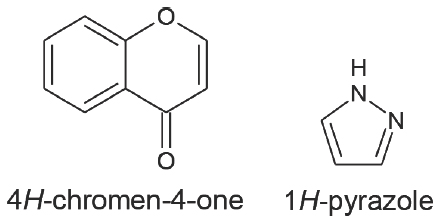
Figure 1:
Chromones and Pyrazole heterocyclic nucleus
MATERIALS AND METHODS
Materials
Chromones and pyrazole were synthesized by using phosphorus oxychloride, 1-(4-chloro-2-hydroxy-5-methylphenyl)ethanone, penta fluoro benzoic acid, 2, 3, 4, 5-Tetrafluorobenzoic acid, Pyridine, Hydrazine Hydrate, Guanidine Hydrochloride, Ethanol, Con. Hydrochloric acid. Chemicals of analytical grade were employed throughout. All chemicals were purchased from Modern Chemicals in Nashik and Atmaja Chemicals in Aurangabad.
Methods
All the chromones and pyrazole derivatives were prepared by the conventional reflux method. The melting points were calculated using the open tube capillary technique. Thin Layer Chromatography (TLC) plates were used to employ silica gel G in various solvent systems, such as chloroform: ethanol (6:4) and chloroform: methanol (8:2), and to test the purity of the chemicals. Using UV light and iodine vapors, the spots were located. Schemes 1 and 2 show the synthesis of these chromones and pyrazole derivatives. Figures 2 and 3.
EXPERIMENTAL WORK
(Scheme I)
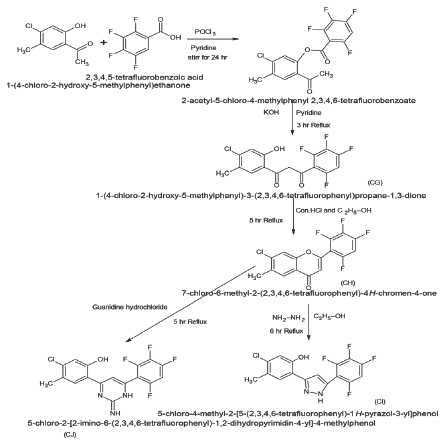
Figure 2:
Scheme 1: Synthesis of 7-chloro-6-methyl-2-(2,3,4,6-tetrafl uorophenyl)-4H-chromen-4-one derivative’s
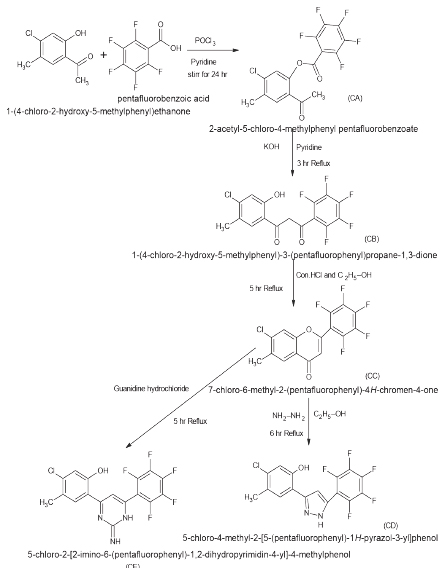
Figure 3:
Scheme 2: 7-chloro-6-methyl-2-(pentafluorophenyl)-4H-chromen-4 -one derivatives
PROCEDURE
Synthesis of 2-acetyl-5-chloro-4-methylphenyl pentafluorobenzoate (CA): (Scheme 2)
In the presence of POCl3 (5 mL) and pyridine (15 mL), Pentafluorobenzoic acid (0.5 g) and 1-(4-chloro-2-hydroxy-5-m ethylphenyl)ethanone (0.5 g) interact with one another. After 20 to 24 hr of stirring on a magnetic stirrer, the reaction produces 2-acetyl-5-chloro-4-methylphenyl pentafluorobenzoate (CA), which solidifies when ice-cold water is added.
Synthesis of 1-(4-chloro-2-hydroxy-5-methylphenyl)- 3-(pentafluorophenyl) propane-1,3-dione (CB): (Scheme 2)
After 3 hr of refluxing a mixture of 2-acetyl-5-chloro- 4-methylphenyl pentafluorobenzoate (CA), potassium hydroxide (0.5 g), and pyridine (5 mL), the reaction was finished. The completeness of the reaction was verified by TLC. The mixture was cooled by the ice addition. The precipitate formed when ethanol was re-crystallized and washed with water yields 1-(4-chloro-2-hydroxy-5-methylphenyl)-3-(pentafluorophenyl) propane-1,3-dione (CB).
Synthesis of 7-chloro-6-methyl-2-(pentaflu orophenyl)-4H-chromen-4-one (CC): (Scheme 2)
Using ordinary hydrochloric acid (5 mL), ethanol (5 mL), and 1-(4-chloro-2-hydroxy-5-methylphenyl)-3-(pentafluorophenyl) propane-1,3-dione (CB), the reaction is carried out and left to reflux for 5 hr. TLC demonstrated that the reaction was over. The mixture was cooled by the ice addition. The precipitate that had developed became 7-chloro-6-methyl-2-(pentafluorophenyl)- 4H-chromen-4-one (CC) after being washed with water and crystallised from ethanol.
Synthesis of 5-chloro-4-methyl-2-[5-(pentaflu orophenyl)-1H-pyrazol-3-yl]phenol (CD): (Scheme 2)
The completion of the reaction was verified by TLC after a solution of 7-chloro-6-methyl-2-(pentafluorophenyl)-4H-chromen-4-one (CC) reacted with hydrazine hydrate (5 mL) and ethanol (10 mL) and refluxed for 6 hr. The addition of ice chilled the mixture. The result of recrystallizing the precipitate from ethanol after it had been rinsed with water is 5-chloro-4-methyl-2-[5-(pentaflu orophenyl)-1H-pyrazol-3-yl] phenol (CD).
Synthesis of 5-chloro-2-[2-imino-6- (pentafluorophenyl)-1,2-dihydropyrimidin-4-yl]-4-m ethylphenol (CE): (Scheme 2)
A solution of 7-chloro-6-methyl-2-(pentafluorophenyl)-4H -chromen-4-one (CC) react with guanidine hydrochloride (5 mL) in the presences of acid and it was reflux for 5 hr and then Completion of the reaction were confirmed by TLC. The addition of ice chilled the mixture. After being recrystalized from ethanol, the precipitate was washed with water and produced 5-chloro- 2-[2-imino-6-(pentafluorophenyl)-1,2-dihydropyrimidin-4-yl] -4-methylphenol.
Synthesis of 2-acetyl-5-chloro-4-methylphenyl 2,3,4,6-tetrafluorobenzoate (CF): (Scheme 1)
In the presence of POCl3 (5 mL) and pyridine (15 mL), a mixture of 1-(4-chloro-2-hydroxy-5-methylphenyl)ethanone and 2,3,4,5-tetrafluorobenzoic acid reacts to form 2-acetyl-5-chloro- 4-methylphenyl 2,3,4,6-tetrafluorobenzoate (CF), which is a solid after the addition of ice cold water.
Synthesis of 1-(4-chloro-2-hydroxy-5-methylphenyl)- 3-(2,3,4,6-tetrafluorophenyl)propane-1,3-dione (CG): (Scheme 1)
The completion of the reaction was verified by TLC after a solution of 2-acetyl-5-chloro-4-methylphenyl 2,3,4,6- tetrafluorobenzoate (CF) react with potassium hydroxide (0.5 g) and pyridine (5 mL) and reflux for 5 h. The addition of ice chilled the mixture. The result of recrystallizing the precipitate from ethanol after it had been rinsed with water is 1-(4-chloro-2-hydroxy-5-methylphenyl)-3- (2,3,4,6-tetrafluorophenyl)propane-1,3-dione (CG).
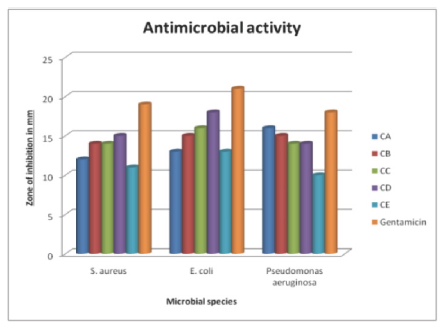
Figure 4:
Antibacterial Activity of CA to CE With Gentamicin
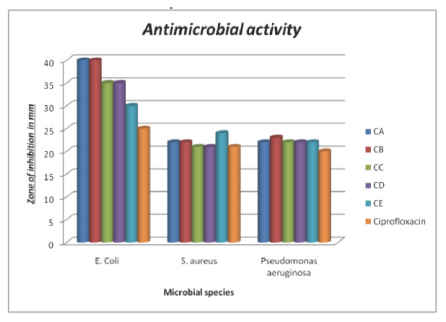
Figure 5:
Antibacterial Activity of CA to CE With Ciprofloxacin
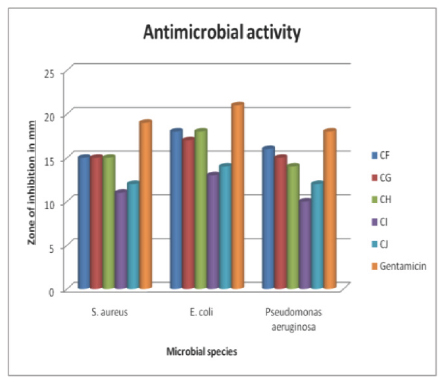
Figure 6:
Antibacterial Activity of CF to CJ With Gentamicin
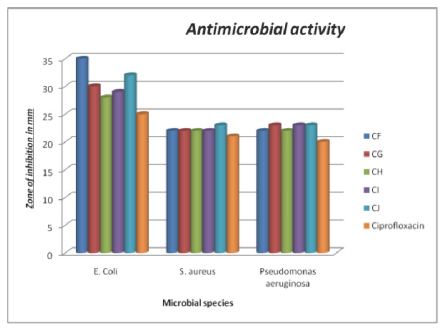
Figure 7:
Antibacterial Activity of CF to CJ With Ciprofloxacin
Synthesis of 7-chloro-6-methyl-2-(2,3,4,6-tetrafl uorophenyl)-4H-chromen-4-one (CH): (Scheme 1)
The completion of the reaction was verified by TLC after a solution of 1-(5-chloro-2-hydroxy-4-methylphenyl)-3- (pentafluorophenyl) propane-1,3-dione (CB) was refluxed for 6 hr with con. hydrochloric acid (5 mL) and ethanol (5 mL). The addition of ice chilled the mixture. The ethanol was recrystallized from the precipitate after it had been washed with water, producing 7-chloro-6-methyl-2-(2,3,4,6-tetrafluorophenyl). Chromone -4H-one (CH).
Synthesis of 5-chloro-4-methyl-2-[5-(2,3,4,6-tetrafl uorophenyl)-1H-pyrazol-3-yl]phenol (CI): (Scheme 1)
The completion of the reaction was verified by TLC after a solution of 7-chloro-6-methyl-2-(2,3,4,6-tetrafluorophenyl)-4H- chromen-4-one (CH) reacted with hydrazine hydrate (5 mL) and ethanol (10 mL) and refluxed for 10 hr. The addition of ice chilled the mixture. When the precipitate is recrystallized from ethanol after being rinsed with water, it produces 5-chloro-4-methyl-2- [5-(2,3,4,6-tetrafluorophenyl)-1H-pyrazol-3-yl]phenol (CI).
Synthesis of 5-chloro-2-[2-imino-6- (2,3,4,6-tetrafluorophenyl)-1,2-dihydropyrimidin-4- yl]-4-methylphenol (CJ): (Scheme 1)
The completion of the reaction was verified by TLC after guanidine hydrochloride (5 mL) and a solution of 7-chloro-6-methyl- 2-(2,3,4,6-tetrafluorophenyl)-4H-chromen-4-one (CH) were refluxed for 10 hr. The addition of ice chilled the mixture. After being recrystallized from ethanol, the precipitate was washed with water and produced 5-chloro-2-[2-imino-6- (2,3,4,6-tetrafluorophenyl)-1,2-dihydropyrimidin-4-yl]- 4-methylphenol (CJ).
Characterization
We prepared 6 derivatives of 4H-chromen-4-one and 1H-pyrazol which were listed in below Table 1.
Physical characteristic like TLC, Rf value, M.P. and % yield of 7-chloro-6-methyl-2-(pentafluorophenyl)-4H-chromen-4-one derivatives and 7-chloro-6-methyl-2-(2,3,4,6-tetrafluorophenyl)- 4H-chromen-4-one derivative’s were listed in above Table 2.
Spectral Data
Synthesis of 2-acetyl-5-chloro-4-methylphenyl pentafluorobenzoate (CA): (Scheme 2)
FTIR (KBr) v cm-1:3062 (Ar C-H stretching), 1641 (Ar C=C), 797 (Ar C=C stretching), 1172 (Ar C-F stretching), 796 (Ar C-Cl stretching),1730 (Ester C=O stretching), 1366 (C-O stretching; 1H NMR (400 MHz CDC13 S ppm): 2.34 (s, 3H, CH3, J = 13.7 Hz), 7.44-7.81 Ar C-H (m, 2H, J = 15.9 Hz), 2.50 (s, 3H, CH3, J = 11.9 Hz); JEOL GCMATE II MS (m/z): 365(M+), 366 (M++1) Mol. Wt.:366.
Synthesis of 1-(4-chloro-2-hydroxy-5-methylphenyl)- 3-(pentafluorophenyl) propane-1,3-dione (CB): (Scheme 2)
FTIR (KBr) v cm-1:3061 (Ar C-H stretching), 1568 (Ar C=C stretching), 884 (Ar C-H stretching), 1171 (Ar C-F stretching), 723 (Ar C-Cl stretching), 1641 (Aryl Ketone C=O stretching), 1250 (C-O stretching), 3573(O-H stretching); 1H NMR (400 MHz CDCl3 S ppm): 3.81 C-H (s, 2H CH2), 5.35 O-H (s, 1H, O-H), 2.34 (s, 3H, CH3), 7.02-7.57 Ar C-H, (m, 3H Ar); JEOL GCMATE II GC-MS (m/z): 377(M+), 378 (M++1) Mol. Wt.:366.
Synthesis of 7-chloro-6-methyl-2-(pentaflu orophenyl)-4H-chromen-4-one (CC): (Scheme 2)
FTIR (KBr) v cm-1:3028 (Ar C-H stretching), 1529 (Ar C=C stretching), 846 (Ar C-H stretching), 1108 (Ar C-F stretching), 769 (Ar C-Cl stretching), 1668 (Aryl Ketone C=O stretching), 1350 (C-O stretching); 1H NMR(400 MHz CDCl3 S ppm):6.54 Ar C-H (s, 2H CH2), 2.34 C-H (s, 3H, CH3), 7.10-7.52 Ar C-H (m, 3H Ar); JEOL GCMATE II MS (m/z): 359(M+), 360 (M++1). Mol. Wt.:360.
Synthesis of 5-chloro-4-methyl-2-[5-(pentaflu orophenyl)-1H-pyrazol-3-yl] phenol (CD): (Scheme 2)
FTIR (KBr) v cm-1 3025 (Ar C-H stretching), 1645 (Ar C=C stretching), 755 (Ar C-H stretching), 1273 (Ar C-F), 652 (Ar C-Cl stretching),3535 (Ar O-H stretching), 1378 (C-O stretching), 3477 (Ar N-H stretching); 1H NMR (400 MHz CDCl3 S ppm): 6.97-7.72 Ar C-H (m, 3H Ar), 2.34 C-H (s, 3H, CH3), 5.35 O-H (s, 1H, O-H), 6.81 C-H (s, 2H CH2),12.62 N-H (s, 1H); JEOL GCMATE II MS (m/z): 373(M+), 374 (M++1). Mol. Wt.:374.
Synthesis of 5-chloro-2-[2-imino-6-(pentafluorophenyl)-1,2-dihydropyrimidin-4-yl]-4-m ethylphenol (CE): (Scheme 2)
FTIR (KBr) v cm-1:3025 (Ar C-H stretching), 1631 (Ar C=C stretching), 817 (Ar C-H stretching), 1118 (Ar C-F stretching), 752 (Ar C-Cl stretching), 3385 (Ar O-H stretching), 1319 (C-O stretching), 3364 (N-H stretching); 1H NMR (400 MHz CDCl3 S ppm): 6.92-7.62 (m, 2H Ar), 2.34 C-H (s, 3H, CH3), 5.35 O-H (s, 1H, O-H), 6.31 C-H (s, 2H CH2), 13.86 N-H (s, 1H), 13.76 N-H (s, 1H); JEOL GCMATE II GC-MS (m/z):394 (M+), 394 (M++1). Mol. W
Synthesis of 2-acetyl-5-chloro-4-methylphenyl 2,3,4,6-tetrafluorobenzoate (CF): (Scheme 1)
FTIR (KBr) v cm-1:3036 (Ar C-H), 1592 (Ar C=C stretching), 747 (Ar C-H stretching), 1115 (Ar C-F stretching), 796 (Ar C-Cl stretching), 1750 (Ester C=O stretching), 1334 (C-O stretching); 1H NMR (400 MHz CDCl3 S ppm): 2.34 C-H (s, 3H, CH3), 7.44-7.81 Ar C-H (m, 2H Ar), 2.50 C-H (s, 3H, CH3), 7.6 Ar C-H (m, 1H Ar); JEOL GCMATE II GC-MS (m/z):359(M+), 360 (M++1) Mol. Wt.:360.
Synthesis of 1-(4-chloro-2-hydroxy-5-methylphenyl)- 3-(2,3,4,6-tetrafluorophenyl)propane-1,3-dione (CG): (Scheme 1)
FTIR (KBr) v cm-1:1568 (Ar C=C stretching), 884 (Ar C-H stretching), 1171(Ar C-F stretching), 723 (Ar C-Cl stretching), 1641 (Aryl Ketone C=O stretching), 1250 (C-O stretching), 3573 (Ar O-H stretching); 1H NMR (400 MHz CDCl3 S ppm): 3.81 C-H (s, 2H CH2), 5.35 O-H (s, 1H, O-H), 2.34 C-H (s, 3H, CH3), 7.02-7.57 Ar C-H (m, 3H Ar7.4 Ar C-H (m, 1H Ar); JEOL GCMATE II GC-MS (m/z):358 (M+), 359 (M++1) Mol. Wt.:359.
Synthesis of 7-chloro-6-methyl-2-(2,3,4,6-tetrafl uorophenyl)-4H-chromen-4-one (CH): (Scheme 1)
FTIR (KBr) v cm-1:3029 (Ar C-H stretching), 1607 (Ar C=C stretching), 846 (Ar C-H stretching), 1158 (Ar C-F stretching), 688 (Ar C-Cl stretching), 1719 (Aryl Ketone C=O stretching), 1349 (C-O stretching); 1H NMR (400 MHz CDCl3 S ppm):6.54 Ar C-H (s, 1H), 6.8 Ar C-H (m, 1H), 2.34 (s, 3H, CH3), 7.10-7.52 Ar C-H (m, 2H); JEOL GCMATE II GC-MS (m/z):341(M+), 342 (M++1). Mol. Wt.:342.
Synthesis of 5-chloro-4-methyl-2-[5-(2,3,4,6-tetrafl uorophenyl)-1H-pyrazol-3-yl]phenol (CI): (Scheme 1)
FTIR (KBr) v cm-1:3073 (Ar C-H stretching), 1645 (Ar C=C stretching), 755 (Ar C-H stretching), 1312 (Ar C-F stretching), 688 (Ar C-Cl stretching),3565 (Ar O-H stretching), 1378 (C-O stretching), 3383 (N-H stretching); 1H NMR (400 MHz CDCl3 ô ppm): 6.97-7.72 Ar C-H (m, 2H), 2.34 C-H (s, 3H, CH3), 6.8 C-H (m, 1H Ar), 5.35 O-H (s, 1H, O-H), 6.81 C-H (s, 2H CH2), 12.62 N-H (s, 1H); JEOL GCMATE II GC-MS (m/z): 355 (M+), 356 (M++1). Mol. Wt.:356.
Synthesis of 5-chloro-2-[2-imino-6- (2,3,4,6-tetrafluorophenyl)-1,2-dihydropyrimidin-4- yl]-4-methylphenol (CJ): (Scheme 1)
FTIR (KBr) v cm-1:3025 (Ar C-H stretching), 1631 (Ar C=C stretching), 817 (Ar C-H stretching), 1155 (Ar C-F stretching), 755 (Ar C-Cl stretching), 3591 (Ar O-H stretching), 1319 (C-O stretching), 3363 (N-H stretching); 1H NMR (400 MHz CDCl3 ô ppm): 6.92-7.62 Ar C-H (m, 2H), 2.34 C-H (s, 3H, CH3), 6.8 Ar C-H (m, 1H Ar), 5.35 O-H (s, 1H, O-H), 6.31 C-H (s, 2H CH2), 13.86 N-H (s, 1H), 13.76 N-H (s, 1H); JEOL GCMATE II GC-MS (m/z):394 (M+), 395 (M++1). Mol. Wt.:395
Biological evaluation
In vitro Antimicrobial Activity by Agar Well Diffusion Method
To evaluate the antibacterial activity of diverse drugs, the agar well diffusion method was employed. Mueller Hinton Agar (MHA) was prepared in accordance with the manufacturer’s instructions, and 100 L of the bacterial solution were dispersed uniformly across the surface of the agar plates. The inhibitory zone’s millimeter-scale diameter was measured, and the results were recorded. The Minimum Inhibitory Concentration (MIC) was determined using the agar dilution method.11 The plates next underwent a 24-hr period of 37°C bacterial incubation. The lowest concentration of the test material that completely eliminated the microorganism’s capacity to grow visibly was determined to be the MIC. Each experiment was conducted in an aseptic setting. The compounds CA to CE and CF to CJ’s in vitro antibacterial effectiveness against a number of pathogens, including gram-positive Staphylococcus aureus, gram-negative Escherichia coli and s were examined in vitro using the disc diffusion method and Mueller Hinton Agar (M173) media. Tables 3, 4, 5 and 6 below indicate the in vitro antimicrobial activity of 7-chloro-6-methyl-2-(2,3,4,6-tetrafluorophenyl)-4H-chr omen-4-one (CH) and 7-chloro-6-methyl-2-(pentafluorophenyl )-4H-chromen-4-one (CC) derivatives against Gentamycin and Ciprofloxacin.
| Label | Structure |
|---|---|
| CC | |
| CD | |
| CE | |
| CH | |
| CI | |
| CJ |
Structure of 7-chloro-6-methyl-2-(pentafluorophenyl)- 4H-chromen-4-one derivatives and 7-chloro-6-methyl-2- (2,3,4,6-tetrafluorophenyl)-4H-chromen-4-one derivatives
RESULTS AND DISCUSSION
The results showed that most synthetic compounds in varied degrees inhibited the studied bacteria. In general, compared to some gram-negative bacteria, some gram-positive bacteria investigated exhibit greater inhibition from inhibitory activity. In addition, substances having code names like 5-chloro-4-methyl-2-[5-(pentafluorophenyl)-1H-pyrazol-3 -yl]; 7-chloro-6-methyl-2-(pentafluorophenyl)-4H-chrome n-4-one (CC); 5-Chloro-2-[2-imino-6-(pentafluorophenyl)- 1,2-dihydropyrimidin-4-yl]phenol (CD); 4-methylphenol (CE), 1-(4-chloro-2-hydroxy-5-methylphenyl)-3-
| Comp. Name | TLC image | R f value | M.P (°C) | % Yields | Comp. Name | TLC image | R f value | M.P (°C) | % Yields |
|---|---|---|---|---|---|---|---|---|---|
| CC | 0.93 | 188-192 | 78 | CH | 0.73 | 168-172 | 71 | ||
| CD | 0.85 | 187-191 | 69 | CI | 0.79 | 178-182 | 94 | ||
| CE | 0.78 | 183-186 | 81 | CJ | 0.68 | 176-179 | 86 |
TLC, Rfb value, M.P. and % yield of 7-chloro-6-methyl-2-(pentafluorophenyl)-4H-chromen-4-one derivatives and 7-chloro-6-methyl-2- (2,3,4,6-tetrafluorophenyl)-4H-chromen-4-one derivative’s
| Compound No. | Diameter of zone of inhibition (mm) | ||
|---|---|---|---|
| Escherichia coli | Staphylococcus aureus | Pseudomonas aeruginosa | |
| ATCC 25922 | ATCC 25923 | ATCC 27853 | |
| CF | 12 | 17 | 09 |
| CG | 10 | 11 | 10 |
| CH | 13 | 20 | 20 |
| CI | 15 | 24 | 21 |
| CJ | 16 | 21 | 19 |
| Gentamycin | 20 | 36 | 28 |
In vitro Antimicrobial Activity of 7-chloro-6-methyl-2- (2,3,4,6-tetrafluorophenyl)-4H-chromen-4-one (CH) derivatives against Gentamycin
| Compound No. | Diameter of zone of inhibition (mm) | ||
|---|---|---|---|
| Escherichia coli | Staphylococcus aureus | Pseudomonas aeruginosa | |
| ATCC 25922 | ATCC 25923 | ATCC 27853 | |
| CA | 12 | 18 | 10 |
| CB | 08 | 15 | 09 |
| CC | 13 | 20 | 19 |
| CD | 14 | 22 | 20 |
| CE | 14 | 21 | 21 |
| Gentamycin | 20 | 36 | 28 |
In vitro Antimicrobial Activity of 7-chloro-6-methyl-2-(pentaflu orophenyl)-4H-chromen-4-one (CC) against Gentamycin
| Compound No. | Diameter of zone of inhibition (mm) | ||
|---|---|---|---|
| Escherichia coli | Staphylococcus aureus | Pseudomona. aeruginosa | |
| ATCC 25922 | ATCC 25923 | ATCC 27853 | |
| CF | 14 | 24 | 14 |
| CG | 12 | 21 | 17 |
| CH | 13 | 20 | 20 |
| CI | 15 | 24 | 21 |
| CJ | 16 | 21 | 17 |
| Ciprofloxacin | 20 | 36 | 28 |
In vitro Antimicrobial Activity of 7-chloro-6-methyl-2- (2,3,4,6-tetrafluorophenyl)-4H-chromen-4-one (CH) derivatives against Ciprofloxacin
| Compound No. | Diameter of zone of inhibition (mm) | ||
|---|---|---|---|
| Escherichia coli | Staphylococcus aureus | Pseudomonas aeruginosa | |
| ATCC 25922 | ATCC 25923 | ATCC 27853 | |
| CA | 18 | 18 | 16 |
| CB | 16 | 15 | 24 |
| CC | 15 | 20 | 19 |
| CD | 14 | 22 | 20 |
| CE | 14 | 21 | 21 |
| Ciprofloxacin | 20 | 36 | 28 |
In vitro Antimicrobial Activity of 7-chloro-6-methyl-2-(pentaflu orophenyl)-4H-chromen-4-one (CC) against Ciprofloxacin
(2,3,4,6-tetrafluorophenyl)propane-1,3-dione (CG), 7-chloro-6- methyl-2-(2,3,4,6-tetrafluorophenyl)-4H-chromen-4-one (CH), 5-chloro-4-methyl-2-[5-(2,3,4,6-te against S. aureus and Pseudomonas aeruginosa using 4-methylphenol (CJ). Moreover, the compounds code name like 2-acetyl-5-chloro- 4-methylphenyl pentafluorobenzoate (CA); 1-(4-chloro- 2-hydroxy-5-methylphenyl)-3-(pentafluorophenyl) propane-1,3-dione: (CB); 2-acetyl-5-chloro-4-methylphenyl 2,3,4,6-tetrafluorobenzoate (CF); 1-(4-chloro-2-hydroxy-5- methylphenyl)-3-(2,3,4,6-tetrafluorophenyl)propane-1,3-dione (CG) against Escherichia coli. The antibacterial activity was marginally boosted as a result of the oxygen atom being swapped out for a nitrogen atom. Our research revealed that all the compounds had a stronger antibacterial effect against Gram-positive bacteria than they did against Gram-negative bacteria. The novel synthesised compounds 5-chloro-4-methyl- 2-[5-(pentafluorophenyl)-1H-pyrazol-3-yl] phenol (CD) and 7-chloro-6-methyl-2-(pentafluorophenyl)-4H-chromen-4-one (CC) both demonstrated good, considerable antimicrobial activity against Ciprofloxacin and Gentamycin. Tables 3 to 6 display the findings of preliminary antimicrobial testing of the produced compounds using common broad-spectrum antibacterial medications like Ciprofloxacin and Gentamycin. Zones of Inhibition of 7-chloro-6-methyl-2-(pentafluorophenyl)-4H-c hromen-4-one (CC) and 7-chloro-6-methyl-2-(2,3,4,6-tetrafl uorophenyl)-4H-chromen-4-one (CC) were tested for the ability of the synthesized compounds to inhibit bacteria. The effects of -4H chromen-4-one (CH) against antibiotics like Ciprofloxacin and Gentamycin are depicted in Figures 4–7.
CONCLUSION
Ciprofloxacin and Gentamycin, the usual reference substance for this investigation, showed the best activity against all tested germs at all tested levels. At a dosage of 100 g/mL, both Ciprofloxacin and Gentamycin demonstrated moderate to strong activity against all three bacteria in addition to inhibitory zones. The activity of these drugs, however, is lower than that of the widely used reference substance, ciprofloxacin. More study is needed to comprehend the mechanism of action and potential clinical applications of these compounds. Furthermore, substances with code names like 7-chloro-6-methyl-2-(pentaflu orophenyl)-4H-chromen-4-one (CC); 5-chloro-4-methyl-2-[5- (pentafluorophenyl)-1H-pyrazol-3-yl] phenol (CD); 5-chloro- 2-[2-imino-6-(pentafluorophenyl)-1,2-dihydropyrimidin-4-yl]- 4-methylphenol (CE); 1-(4-chloro-2-hydroxy-5-methylphenyl)- 3-(2,3,4,6-tetrafluorophenyl)propane-1,3-dione (CG); 7-chloro-6-methyl-2-(2,3,4,6-tetrafluorophenyl)-4H-chr omen-4-one (CH); 5-chloro-4-methyl-2-[5-(2,3,4,6-tetrafl uorophenyl)-1H-pyrazol-3-yl]phenol(CI); 5-chloro-2-[2-imino- 6-(2,3,4,6-tetrafluorophenyl)-1,2-dihydropyrimidin-4-yl]-4-me thylphenol (CJ) against S. aureus and Pseudomonas aeruginosa.
Cite this article
Bhor RJ, Kadam KS, Sitaram GM. Synthesis, Characterization, and in vitro Antimicrobial Screening of Some “1H-Pyrazole’s and 4 H -Chromen-4-One’s Derivatives with Penta- Fluoro-Benzoic Acid and 2,3,4,5-Tetra-Fluoro-Benzoic Acid”. Int. J. Pharm. Investigation. 2023;13(4):875-82.
ACKNOWLEDGEMENT
The authors are thankful to Dr. S.B. Bhawar, Pravara Rural College of Pharmacy, Pravaranagar.
ABBREVIATIONS
| FTIR: | Fourier transform infrared spectroscopy |
|---|---|
| NMR spectroscopy: | Nuclear magnetic spectroscopy |
| MS: | Mass spectroscopy |
| KBr: | Potassium Bromide |
| % yield: | Percentage yields |
| M.P.: | Melting point |
| mg/kg: | Milligram/ kilograms |
| sec: | seconds |
| 8: | Chemical shift |
| Mol. Wt: | Molecular Weight |
| gm: | Gram |
References
- Ansari A, Ali A, Asif M, Shamsuzzaman S. Review: biologically active pyrazole derivatives. New J Chem. 2017;2017(1):16-41. [CrossRef] | [Google Scholar]

- Steinbach G, Lynch PM, Phillips RK, Wallace MH, Hawk E, Gordon GB, et al. The effect of celecoxib, a cyclooxygenase-2 inhibitor, in familial adenomatous polyposis. N Engl J Med. 2000;2000(26):1946-52. [PubMed] | [CrossRef] | [Google Scholar]

- Uslaner JM, Parmentier-Batteur S, Flick RB, Surles NO, Lam JSH, McNaughton CH, et al. Dose-dependent effect of CDPPB, the mGluR5 positive allosteric modulator, on recognition memory is associated with GluR1 and CREB phosphorylation in the prefrontal cortex and hippocampus. Neuropharmacology. 2009;57(5-6):531-8. [PubMed] | [CrossRef] | [Google Scholar]

- Friedrich G, Rose T, Rissler K. Determination of lonazolac and its hydroxy and O-sulfated metabolites by on-line sample preparation liquid chromatography with fluorescence detection. J Chromatogr B Analyt Technol Biomed Life Sci. 2002;2002(2):295-305. [PubMed] | [CrossRef] | [Google Scholar]

- Hampp C, Hartzema AG, Kauf TL. Cost-utility analysis of rimonabant in the treatment of obesity. Value Health. 2008;2008(3):389-99. [PubMed] | [CrossRef] | [Google Scholar]

- Spitz IM, Novis BH, Ebert R, Trestian S, LeRoith D, Creutzfeldt W, et al. Betazole-induced GIP secretion is not mediated by gastric HCl. Metabolism. 1982;1982(4):380-2. [CrossRef] | [Google Scholar]

- García-Lozano J, Server-Carrió J, Escrivà E, Folgado JV, Molla C, Lezama L, et al. X-ray crystal structure and electronic properties of chlorobis(mepirizole)copper(II) tetrafluoroborate (mepirizole = 4-methoxy-2-(5-methoxy-3-methyl-1H-p yrazol-1-yl)-6-methylpyrimidine). Polyhedron. 1997;1997(6):939-44. [CrossRef] | [Google Scholar]

- Kameyama T, Nabeshima T. Effects of 1,3-diphenyl-5-(2-dimethyl amino propionamide)-pyrazole[difenamizole] on a conditioned avoidance response. Neuropharmacology. 1978;17(4-5):249-56. [PubMed] | [CrossRef] | [Google Scholar]

- Knorr L. Einwirkung von Acetessigester auf Phenylhydrazin. Ber Dtsch Chem Ges. 1883;1883(2):2597-9. [CrossRef] | [Google Scholar]

- Girish YR, Kumar KSS, Manasa HS, Shashikanth S. An ecofriendly, green nanocatalyst for the synthesis of pyrazole derivatives under aqueous media. J Chin Chem Soc. 2014;2014(11):1175-9. [CrossRef] | [Google Scholar]

- Ohtsuka Y, Uraguchi D, Yamamoto K, Tokuhisa K, Yamakawa T. Syntheses of 2-(trifluoromethyl)-1,3-dicarbonyl compounds through direct trifluoromethylation with CF3I and their application to fluorinated pyrazoles syntheses. Tetrahedron. 2012;2012(12):2636-49. [CrossRef] | [Google Scholar]


